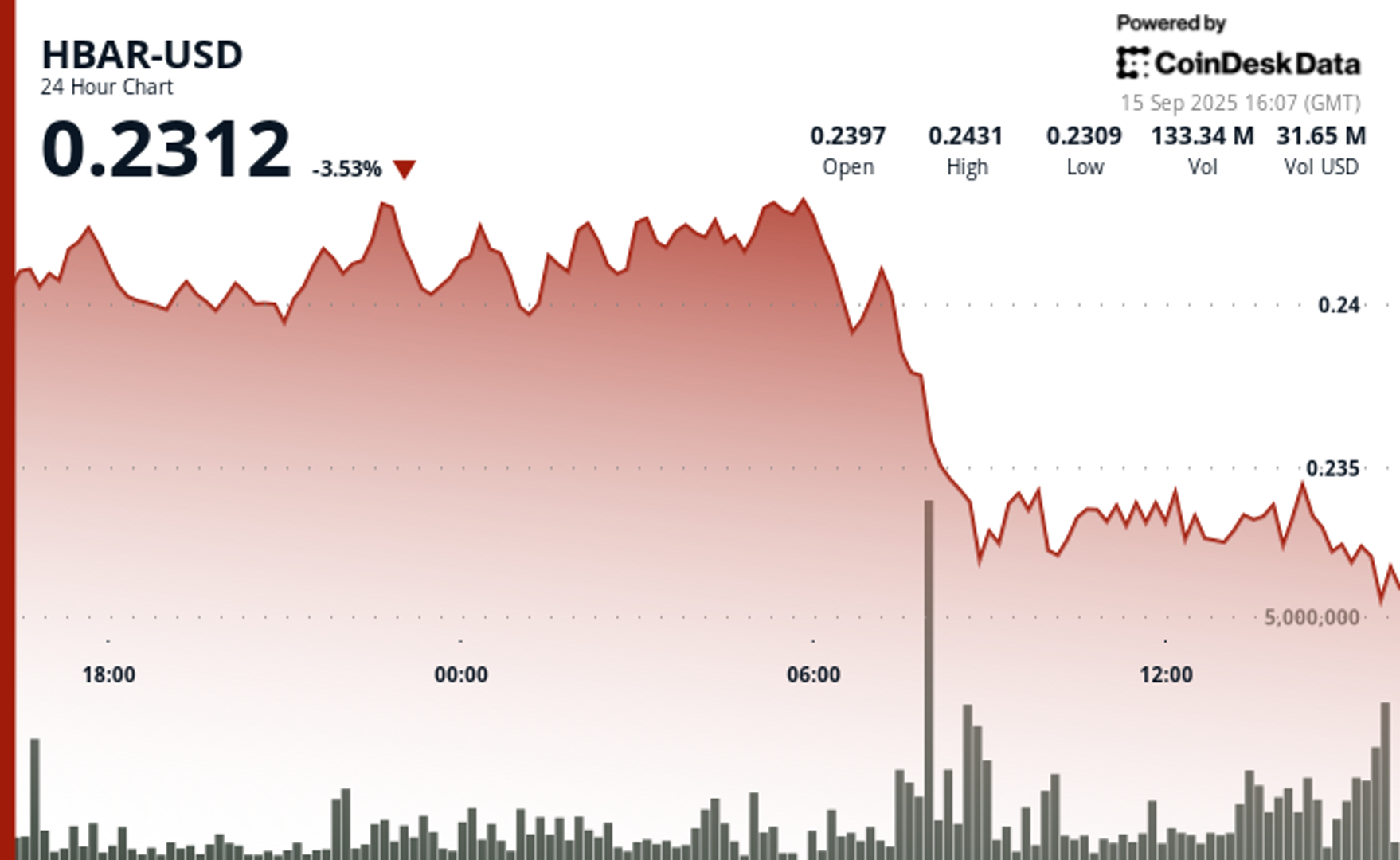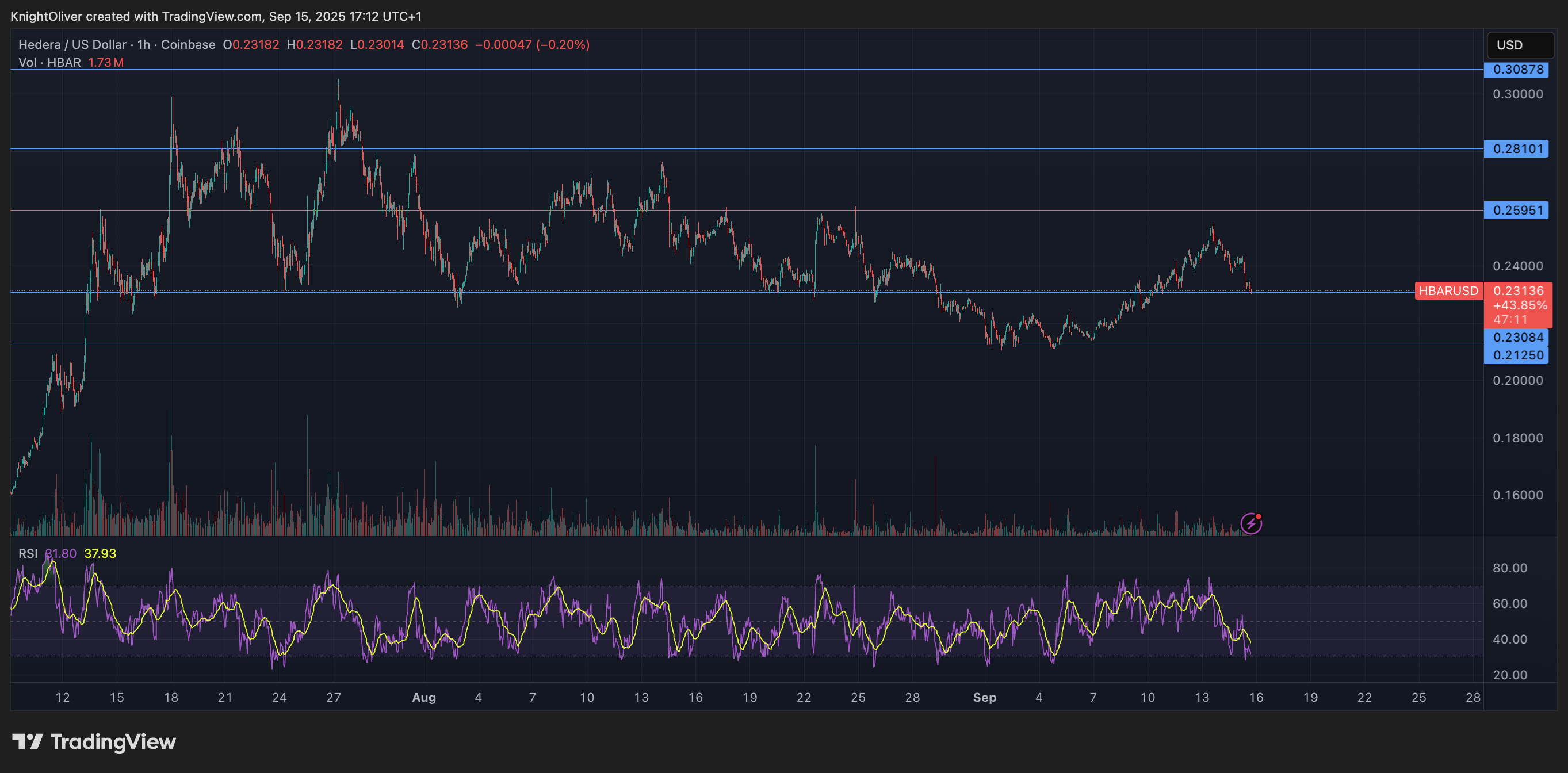Uncategorized
Asia Morning Briefing: The First AI vs BTC Environmental Impact Numbers are Here. And it Might Start a New Debate

Good Morning, Asia. Here’s what’s making news in the markets:
Welcome to Asia Morning Briefing, a daily summary of top stories during U.S. hours and an overview of market moves and analysis. For a detailed overview of U.S. markets, see CoinDesk’s Crypto Daybook Americas.
Mistral AI recently offered a rare benchmark in the Artificial Intelligence industry’s environmental disclosure, detailing the footprint of its flagship large language model, Mistral Large 2.
Over 18 months, training and operating this model generated 20.4 kilotonnes of CO₂-equivalent emissions, consumed 281,000 cubic meters of water, and depleted 660 kilograms of antimony-equivalent materials, Mistral’s report said. Notably, a single 400-token response from its chatbot, Le Chat, uses just 1.14 grams of CO₂, 45 mL of water, and 0.16 milligrams of mineral resources.
But how does this compare to bitcoin’s carbon footprint? After all, bitcoin’s energy use has been the subject of significant debate and is often cited when establishing bans on bitcoin mining in jurisdictions.
That makes AI inference seem downright frugal compared to Bitcoin’s proof-of-work engine. On average, one Bitcoin transaction emits between 600 and 700 kilograms of CO₂, consumes more than 17,000 liters of water, and generates over 130 grams of electronic waste.
Zooming out, the entire Bitcoin network emitted roughly 48 million tonnes of CO₂ in 2023, according to the Cambridge Centre for Alternative Finance. It also consumed over 2 billion liters of water and produced more than 20,000 tonnes of e-waste.
However, the Cambridge Centre’s numbers, although peer-reviewed, have been the source of considerable criticism and require important caveats.
First, Bitcoin’s electricity mix is not monolithic.
According to a survey of miners conducted by BTC Investment fund Batcoinz as of March 2023, Hydropower (23.1%), wind (13.9%), and solar (5%) collectively account for more than 40% of Bitcoin’s energy consumption. The difference between the numbers is because surveys done by Batcoinz include off-grid generation.
Nuclear energy, often considered carbon-neutral, accounts for another 7.9%. Gas and coal together represent 44%, but Bitcoin’s energy profile is more diversified than critics often assume.
Second, LLMs may benefit from a cleaner grid by default. For example, nuclear energy comprises over 22% of the European Union’s electricity generation, which reduces the CO₂ emissions associated with model training and inference in EU-based data centers such as Mistral’s.
That advantage isn’t due to model architecture, it’s grid geography. A U.S.-based training run drawing from coal-heavy regions would present a very different environmental profile.
So while the marginal footprint of using an LLM is vastly smaller than processing a BTC transaction, both operate within infrastructure landscapes that significantly shape their true environmental impact.
Training frontier models like GPT-4 or Gemini can still require millions of GPU-hours and heavy water consumption, depending on location. Still, Bitcoin’s design, mining every 10 minutes regardless of demand, results in a fixed energy cost that scales with time, not usage.
In contrast, AI’s marginal cost scales with the frequency of model usage. That distinction makes the emissions from a chatbot reply easier to amortize than those from a block reward.
As global scrutiny increases over the environmental costs of computation, transparency initiatives like Mistral’s, provide important reference points.
While proof-of-work is energy-intensive, the Bitcoin blockchain’s halving mechanism steadily reduces the rate at which new coins are created, encouraging miners to become more efficient over time. Its environmental footprint should be weighed against the utility it provides in securing a decentralized, global financial network.
Continued improvements in clean energy adoption and mining optimization will be key for both BTC and AI as they scale into core pillars of the digital economy.
Market Movers:
BTC: Bitcoin is trading at $119,500, struggling to maintain momentum after last week’s all-time high of $123,100, as retail-driven sell pressure on Binance has pushed Net Taker Volume below $60 million and signaled growing bearish sentiment, according to CryptoQuant.
ETH: Ether has pulled back over 3% to $3,696 after a multi-week climb toward $4,000, as technical indicators flash red and analysts question whether the rally can continue without a broader correction, despite ongoing institutional accumulation.
Gold: Gold prices rose nearly 1% on Tuesday, with spot gold reaching a five-week high of $3,430.41 amid ongoing trade uncertainty and falling US bond yields, which continue to draw investor interest.
Nikkei 225: Asia-Pacific markets opened higher after U.S. President Donald Trump announced a “massive Deal” with Japan, lifting tariffs to 15% on Japanese exports, with the Nikkei 225 rising 1.71% at the open.
S&P 500: US stocks closed mixed Tuesday, but the S&P 500 edged slightly higher to a record 6,309.62 as investors weighed earnings reports
Elsewhere in Crypto:
Uncategorized
Wall Street Bank Citigroup Sees Ether Falling to $4,300 by Year-End

Wall Street giant Citigroup (C) has launched new ether (ETH) forecasts, calling for $4,300 by year-end, which would be a decline from the current $4,515.
That’s the base case though. The bank’s full assessment is wide enough to drive an army regiment through, with the bull case being $6,400 and the bear case $2,200.
The bank analysts said network activity remains the key driver of ether’s value, but much of the recent growth has been on layer-2s, where value “pass-through” to Ethereum’s base layer is unclear.
Citi assumes just 30% of layer-2 activity contributes to ether’s valuation, putting current prices above its activity-based model, likely due to strong inflows and excitement around tokenization and stablecoins.
A layer 1 network is the base layer, or the underlying infrastructure of a blockchain. Layer 2 refers to a set of off-chain systems or separate blockchains built on top of layer 1s.
Exchange-traded fund (ETF) flows, though smaller than bitcoin’s (BTC), have a bigger price impact per dollar, but Citi expects them to remain limited given ether’s smaller market cap and lower visibility with new investors.
Macro factors are seen adding only modest support. With equities already near the bank’s S&P 500 6,600 target, the analysts do not expect major upside from risk assets.
Read more: Ether Bigger Beneficiary of Digital Asset Treasuries Than Bitcoin or Solana: StanChart
Uncategorized
XLM Sees Heavy Volatility as Institutional Selling Weighs on Price

Stellar’s XLM token endured sharp swings over the past 24 hours, tumbling 3% as institutional selling pressure dominated order books. The asset declined from $0.39 to $0.38 between September 14 at 15:00 and September 15 at 14:00, with trading volumes peaking at 101.32 million—nearly triple its 24-hour average. The heaviest liquidation struck during the morning hours of September 15, when XLM collapsed from $0.395 to $0.376 within two hours, establishing $0.395 as firm resistance while tentative support formed near $0.375.
Despite the broader downtrend, intraday action highlighted moments of resilience. From 13:15 to 14:14 on September 15, XLM staged a brief recovery, jumping from $0.378 to a session high of $0.383 before closing the hour at $0.380. Trading volume surged above 10 million units during this window, with 3.45 million changing hands in a single minute as bulls attempted to push past resistance. While sellers capped momentum, the consolidation zone around $0.380–$0.381 now represents a potential support base.
Market dynamics suggest distribution patterns consistent with institutional profit-taking. The persistent supply overhead has reinforced resistance at $0.395, where repeated rally attempts have failed, while the emergence of support near $0.375 reflects opportunistic buying during liquidation waves. For traders, the $0.375–$0.395 band has become the key battleground that will define near-term direction.

Technical Indicators
- XLM retreated 3% from $0.39 to $0.38 during the previous 24-hours from 14 September 15:00 to 15 September 14:00.
- Trading volume peaked at 101.32 million during the 08:00 hour, nearly triple the 24-hour average of 24.47 million.
- Strong resistance established around $0.395 level during morning selloff.
- Key support emerged near $0.375 where buying interest materialized.
- Price range of $0.019 representing 5% volatility between peak and trough.
- Recovery attempts reached $0.383 by 13:00 before encountering selling pressure.
- Consolidation pattern formed around $0.380-$0.381 zone suggesting new support level.
Disclaimer: Parts of this article were generated with the assistance from AI tools and reviewed by our editorial team to ensure accuracy and adherence to our standards. For more information, see CoinDesk’s full AI Policy.
Uncategorized
HBAR Tumbles 5% as Institutional Investors Trigger Mass Selloff

Hedera Hashgraph’s HBAR token endured steep losses over a volatile 24-hour window between September 14 and 15, falling 5% from $0.24 to $0.23. The token’s trading range expanded by $0.01 — a move often linked to outsized institutional activity — as heavy corporate selling overwhelmed support levels. The sharpest move came between 07:00 and 08:00 UTC on September 15, when concentrated liquidation drove prices lower after days of resistance around $0.24.
Institutional trading volumes surged during the session, with more than 126 million tokens changing hands on the morning of September 15 — nearly three times the norm for corporate flows. Market participants attributed the spike to portfolio rebalancing by large stakeholders, with enterprise adoption jitters and mounting regulatory scrutiny providing the backdrop for the selloff.
Recovery efforts briefly emerged during the final hour of trading, when corporate buyers tested the $0.24 level before retreating. Between 13:32 and 13:35 UTC, one accumulation push saw 2.47 million tokens deployed in an effort to establish a price floor. Still, buying momentum ultimately faltered, with HBAR settling back into support at $0.23.
The turbulence underscores the token’s vulnerability to institutional distribution events. Analysts point to the failed breakout above $0.24 as confirmation of fresh resistance, with $0.23 now serving as the critical support zone. The surge in volume suggests major corporate participants are repositioning ahead of regulatory shifts, leaving HBAR’s near-term outlook dependent on whether enterprise buyers can mount sustained defenses above key support.

Technical Indicators Summary
- Corporate resistance levels crystallized at $0.24 where institutional selling pressure consistently overwhelmed enterprise buying interest across multiple trading sessions.
- Institutional support structures emerged around $0.23 levels where corporate buying programs have systematically absorbed selling pressure from retail and smaller institutional participants.
- The unprecedented trading volume surge to 126.38 million tokens during the 08:00 morning session reflects enterprise-scale distribution strategies that overwhelmed corporate demand across major trading platforms.
- Subsequent institutional momentum proved unsustainable as systematic selling pressure resumed between 13:37-13:44, driving corporate participants back toward $0.23 support zones with sustained volumes exceeding 1 million tokens, indicating ongoing institutional distribution.
- Final trading periods exhibited diminishing corporate activity with zero recorded volume between 13:13-14:14, suggesting institutional participants adopted defensive positioning strategies as HBAR consolidated at $0.23 amid enterprise uncertainty.
Disclaimer: Parts of this article were generated with the assistance from AI tools and reviewed by our editorial team to ensure accuracy and adherence to our standards. For more information, see CoinDesk’s full AI Policy.
-

 Business11 месяцев ago
Business11 месяцев ago3 Ways to make your business presentation more relatable
-

 Fashion11 месяцев ago
Fashion11 месяцев agoAccording to Dior Couture, this taboo fashion accessory is back
-

 Entertainment11 месяцев ago
Entertainment11 месяцев ago10 Artists who retired from music and made a comeback
-

 Entertainment11 месяцев ago
Entertainment11 месяцев ago\’Better Call Saul\’ has been renewed for a fourth season
-

 Entertainment11 месяцев ago
Entertainment11 месяцев agoNew Season 8 Walking Dead trailer flashes forward in time
-

 Business11 месяцев ago
Business11 месяцев ago15 Habits that could be hurting your business relationships
-

 Entertainment11 месяцев ago
Entertainment11 месяцев agoMeet Superman\’s grandfather in new trailer for Krypton
-

 Entertainment11 месяцев ago
Entertainment11 месяцев agoDisney\’s live-action Aladdin finally finds its stars





